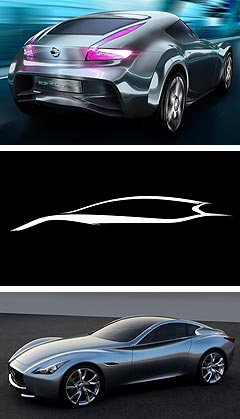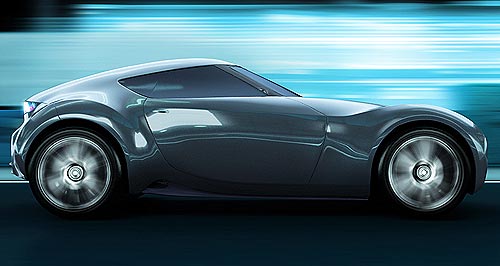Make / Model Search
Future models - Nissan - EsflowGeneva show: Nissan blends Leaf EV with 370ZFlow chart: Nissan’s Esflow concept was designed as an EV from the ground up and features a unique aluminium chassis, composite body and Leaf-based powertrain. Nissan unveils full-electric Esflow sportscar concept ahead of Geneva global debut10 Feb 2011 By TERRY MARTIN NISSAN has signalled its intention to remain in the mainstream when it comes to electric vehicles, unveiling the first images and details of a purposeful and “pure” electric sportscar concept that blends its Leaf EV with the 370Z. To make its world premiere at the Geneva motor show on March 1, the so-called Esflow is a rear-wheel drive two-seater coupe that borrows technology from the Leaf – including the same laminated lithium-ion batteries – but packs in far more performance. Specifications are still scarce at this stage, although Nissan claims the Esflow – which has an electric motor in each rear wheel – can accelerate from 0-100km/h in less than five seconds, and can remain on the road without requiring a recharge for more than 240km. The Leaf is powered by an 80kW/280Nm electric motor and is claimed to have a real-world driving range of 160km. Nissan has not provided official acceleration figures. No specific outputs have been provided for the Esflow, but Nissan says the electric motors are designed to independently control the left and right rear wheels, which in turns optimises torque and maximises power regeneration. The battery packs are mounted low on the vehicle along the axis of the front and rear wheels to centralise the mass of the car and provide good weight distribution.  From top: Nissan Esflow concept, Infiniti silhouette image for upcoming Geneva concept, 2009 Infiniti Essence concept. From top: Nissan Esflow concept, Infiniti silhouette image for upcoming Geneva concept, 2009 Infiniti Essence concept.They are also used to demonstrate how the Esflow was created from the ground up as an EV – not an existing combustion-engined vehicle adapted to run on electricity, “but a sportscar that’s been designed from the outset as a zero emission vehicle”. Nissan says this means that its designers had “free rein to place the powertrain and batteries in the optimum positions to benefit the car’s handling and performance and enhancing the thrill of driving”. “Power cells are incorporated in such a way that they benefit Esflow’s strength and poise, not detract from them,” the company says. “Indeed, unlike a conventional fuel tank, batteries do not get lighter as they provide energy, so the car’s weight distribution remains constant throughout a drive.” The car is built using an aluminium chassis that incorporates rollbars into the structure behind the seats. The powertrain is simply described as employing “the same technologies” as those installed in the Nissan Leaf (“tuned to offer a sporty driving experience”), while the striking bodywork is made from composite materials. With the body, Nissan’s designers point to “hints of classic and contemporary” sportscars with aspects such as the long bonnet, steeply raked (and wraparound, for unobstructed visibility) windscreen, a compact cabin that positions the occupants at the car’s centre of gravity, and flared wheelarches housing large six-spoke wheels (with blue carbon inserts) wrapped in ultra-low-profile tyres. The same blue carbon material is used on the side sills, roof-mounted lip spoiler and lower rear bumper, while blue LED lights are used front and rearFlip-out charge points are built into the air ducts beneath the headlights, and, as is now commonly found on sportscar concepts, the wing mirrors are replaced with cameras to reduce interruptions to the body surfacing work. Inside, Nissan has sculpted the seats into the rear bulkhead, negating the need for heavy steel seat frames, while driver positioning – which is limited with the fixed seating arrangement – is aided by electrically adjustable pedals and (fly-by-wire) steering. Four multifunction LCD displays are the highlights across the dashboard, along with the spark-themed blue and gold motif that runs along the dash and elsewhere across the cabin. The seats are upholstered in gold leather and perforated gold suede while the doors are trimmed in dark blue leather and suede. Meanwhile, Nissan is also preparing to introduce a striking new entry-level performance car concept at the Geneva show for its Infiniti brand – the luxury division that is due to be launched here in the next year or so. The company has issued a silhouetted teaser image of the car, which is expected to materialise as a small coupe-like three-door hatchback that will sit below the current G series. Although it is just an outline, the silhouette indicates that the car will draw heavily from the Essence concept shown at last year’s Geneva show. All Nissan/Infiniti has said at this stage is that the car will “take the Japanese performance brand down a new road, to a new future”. In September last year, Infiniti senior vice-president Andy Palmer said: “Infiniti is currently examining concepts for a luxury performance car that will fit below the current G Line. Like every Infiniti, it will be completely different to anything currently offered by our rivals.” The UK’s Autocar has reported that the new baby model should feature a turbocharged four-cylinder engine sourced from Mercedes-Benz.  Read more1st of October 2010  Paris show: Nissan’s functional, but chic, TownpodNissan takes the covers off its Leaf-based van concept aimed at entrepreneurs27th of September 2010  Paris show: Infiniti’s M35h packs a punchInfiniti’s first hybrid set for 2011 Euro launch as 2013 EV sketch emergesAll future models Alfa Romeo Alfa Romeo Abarth Abarth Alpine Alpine Alpina Alpina Audi Audi Aston Martin Aston Martin BMW BMW Bentley Bentley Chery Chery Brabham Brabham Chrysler Chrysler Chevrolet Chevrolet Cupra Cupra Citroen Citroen DS DS Dodge Dodge Fiat Fiat Ferrari Ferrari Foton Foton Ford Ford Great Wall Great Wall FPV FPV Haval Haval GWM GWM Honda Honda Holden Holden Hummer Hummer HSV HSV Infiniti Infiniti Hyundai Hyundai Jaguar Jaguar Isuzu Isuzu Kia Kia Jeep Jeep Land Rover Land Rover Lamborghini Lamborghini Lexus Lexus LDV LDV Mahindra Mahindra Lotus Lotus Mazda Mazda Maserati Maserati Mercedes-AMG Mercedes-AMG McLaren McLaren MG MG Mercedes-Benz Mercedes-Benz Mitsubishi Mitsubishi Mini Mini Opel Opel Nissan Nissan Peugeot Peugeot Pagani Pagani Proton Proton Porsche Porsche Renault Renault Ram Ram Rover Rover Rolls-Royce Rolls-Royce Skoda Skoda Saab Saab SsangYong SsangYong Smart Smart Suzuki Suzuki Subaru Subaru Toyota Toyota Tesla Tesla Volvo VolvoMotor industry news |
Click to shareNissan modelsResearch Nissan All future models Alfa Romeo Alfa Romeo Abarth Abarth Alpine Alpine Alpina Alpina Audi Audi Aston Martin Aston Martin BMW BMW Bentley Bentley Chery Chery Brabham Brabham Chrysler Chrysler Chevrolet Chevrolet Cupra Cupra Citroen Citroen DS DS Dodge Dodge Fiat Fiat Ferrari Ferrari Foton Foton Ford Ford Great Wall Great Wall FPV FPV Haval Haval GWM GWM Honda Honda Holden Holden Hummer Hummer HSV HSV Infiniti Infiniti Hyundai Hyundai Jaguar Jaguar Isuzu Isuzu Kia Kia Jeep Jeep Land Rover Land Rover Lamborghini Lamborghini Lexus Lexus LDV LDV Mahindra Mahindra Lotus Lotus Mazda Mazda Maserati Maserati Mercedes-AMG Mercedes-AMG McLaren McLaren MG MG Mercedes-Benz Mercedes-Benz Mitsubishi Mitsubishi Mini Mini Opel Opel Nissan Nissan Peugeot Peugeot Pagani Pagani Proton Proton Porsche Porsche Renault Renault Ram Ram Rover Rover Rolls-Royce Rolls-Royce Skoda Skoda Saab Saab SsangYong SsangYong Smart Smart Suzuki Suzuki Subaru Subaru Toyota Toyota Tesla Tesla Volvo VolvoMotor industry news |











Facebook Twitter Instagram